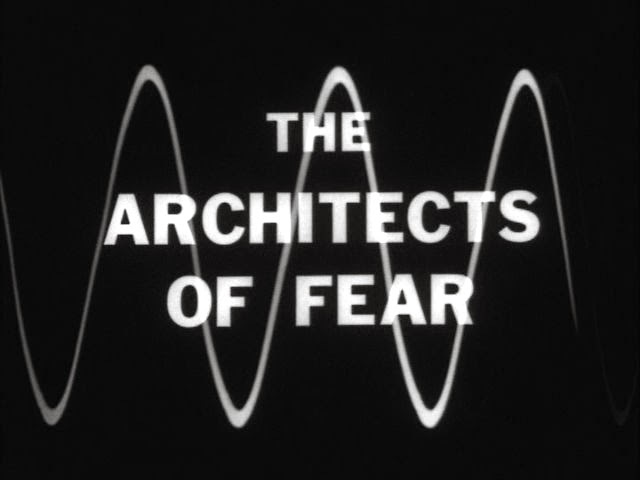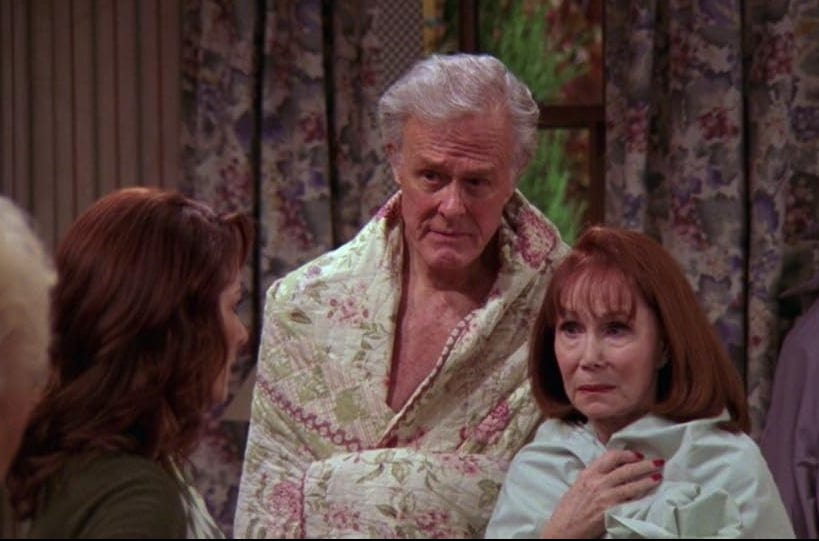The Architects of Fear
The Architects of Fear is an episode from the classic science fiction television series “The Outer Limits.” Scientists devise a plan to unite the warring nations of Earth.
Is this the day? Is this the beginning of the end? There is no time to wonder, no time to ask, “Why is it happening, why is it finally happening?” There is time only for fear, for the piercing pain of panic. Do we pray? Or do we merely run now, and pray later? Will there be a later? Or is this the day?
Opening narration, Architects of Fear
Foreword
The original The Outer Limits is a classic black and white science fiction television series broadcast on A.B.C., scheduled for the 7:30 PM primetime slot. The first episode aired on September 16, 1963. The first season included 32 episodes, and the second season started on September 19, 1964, and encompassed 17 segments. Unlike the Twilight Zone, which emphasizes fantasy or supernatural themes, The Outer Limits captured its audience with science fiction. Also, see my Outer Limits essay O.B.I.T. Overlord.
Introduction
The Architects of Fear is an episode from the classic science fiction television series The Outer Limits. It aired on October 4, 1963. The episode revolves around a group of idealistic scientists. They devise a plan to unite the warring nations of Earth by creating a common extraterrestrial threat. They choose physicist Allen Leighton (Robert Culp 1930-2010) as the subject of a radical surgical procedure. It will transform him into a terrifying creature from another planet. To this day, I vividly remember the episode Architects of Fear first watching it as a youngster of six.
The resource for this essay and inspiration comes from the rare book in my library, Outer Limits: The Official Companion. Enjoy my October 1963 outer limits trip back to the future!
The Plot
A group of undercover scientists forms a close-knit community intending to unite the warring nations on Earth. Their plan involves creating a common enemy, an extraterrestrial being. They dub it the “scarecrow,” which will land a spaceship during a United Nations General Assembly session. The scientists all agree to a random lottery. With their name on a piece of paper, the one picked gets to be the lucky subject to transform into a space alien.
The chosen member to undergo a radical surgical procedure is physicist Allen Leighton. The team was determined to transform into Allen, a “perfect inhabitant of the planet Theta.” To execute the plan, the idealistic scientists stage Allen’s death. He undergoes a grueling series of transplants and body modifications. The ultimate in trans surgery. Trust the science.
Dr. Phillip Gainer (Leonard Stone 1923-2011) performed experimental treatments that profoundly impacted Allen, altering his skin, senses, and internal organs. As a result, Allen’s ability to focus his eyes became impaired, breathing Earth’s air became challenging, and he even required artificial assistance to speak. Experiencing discomfort, he described sensations like a toothache in his arm, itchy eyeballs, and a headache at the base of his neck.
Unbeknownst to Allen, his wife, Yvette (Geraldine Brooks 1925-1977), believes he is still alive. They share a vague psychic connection that allows her to experience pain while he suffers on the operating table.
After the bizarre transformation, Allen launches into orbit under the cover of a “weather satellite.” But, an unforeseen course deviation causes a crash landing. The “alien from outer space” lands in a forest near the United Labs facility where the team conceived the plot. Allen is now a grotesque creature with scales, bird-like feet. He can breathe nitrogen and wields a laser pistol, disintegrating a passing station wagon to warn a group of hunters. In response, the hunters shoot him in the back as he attempts to flee toward the laboratory. Yvette once again feels her husband’s agony and rushes to United Labs, arriving before Allen’s fellow scientists.
In his dying moments, the creature shows a distinctive gesture symbolizing the “mark against evil.” It is a personal sign that Allen had shared only with his wife. In that horrifying moment, Yvette realizes the truth. She now knows the “good” scientists are behind her husband’s transformation and ultimate fate. That scene can be viewed here:
Analysis
The strengths exhibited by the “Architects” in the story interwind with human dilemmas and conflicts. Allen, the protagonist, grapples with his unwavering commitment to scientific ideals. But he maintains a loving relationship with his wife, Yvette.
Dr. Gainer, the lead scientist, has a dedication to the project and remains secretive. Yet, he shows concern for Allen’s suffering, revealing a more compassionate side. The group of scientists, ordinary individuals at heart, have good intentions. But they often fall victim to mistakes and lack of foresight. Nice-sounding decisions can, at times, have destructive consequences.
In their attempt to bring about global unity, the scientists destroy the precious bond two individuals share. Instead of improving the world, they cancel one of its few remaining sources of goodness. Allen’s transformation serves as the desperate effort of an advanced group of geniuses. They attempt to rectify the global nuclear threat resulting from the actions of their predecessors. They shoulder an immense responsibility for humankind, only to falter in their execution. Yet, even with their grave miscalculations, there is a remarkable degree of empathy and understanding.
From the early moments of the episode, it becomes evident that the actions of the scientists are wrong. The notion of transforming a man into an alien is disturbing. It adds to the repulsiveness of the concept. Even so, some adhere to the philosophy of utilitarianism. That is where the greater good of the many outweighs the interests of the individual. In this case, achieving world peace is a noble goal. Allen Leighton, the man undergoing the surgeries, consented.
We never see the elusive prototype Theta alien, only its silhouette with a rattling noise. This leaves us questioning its origins. Did it originate from another planet? And if so, how did it arrive here? The secrecy surrounding its presence raises further intrigue. Why was its arrival kept under wraps? Could the Theta alien in the cage be a miniature prototype engineered from an unfortunate animal? This intensifies the sense of unease and mystery surrounding the story.
Allen’s emotional detachment was evident except for two notable instances. The first occurred in the middle of the episode, when Allen’s demeanor drastically turned, leaving everyone stunned. He roughed up the scene with great abandon, calling himself “Caliban with a Ph.D.” He aimed the X-ray machine at the doctors in a juvenile-like game. The second occurred when Allen’s emotions welled up as Yvette revealed that her doctor had declared her heart murmur, which had been the primary obstacle to their parenthood, was now a thing of the past. Overwhelmed with joy, he couldn’t contain his excitement as she confessed to browsing through maternity clothing.
Watch the full episode here:
Fun Facts
Several ABC local affiliate stations deemed the transformed Allen Leighton too terrifying. As a result, these stations chose to display a black screen during Thetan’s appearances. That censored a significant part of the final act of the show. In certain regions of the United States, the Thetan footage got delayed until after the 11 pm/10c news concluded. In some areas, it was not broadcast at all.
Robert Culp was a prolific actor starring in numerous motion pictures and television shows. In addition to Architects of Fear (October 4, 1963), he also starred in The Outer Limits episodes Corpus Earthling (November 18, 1963) and Demon with a Glass Hand (October 17, 1964). In one of his last roles, Culp played the hilarious role of Warren, the father of Debora Barone (Patricia Heaton). Heaton played the wife of Raymond Barone (Ray Romano) in the sitcom Everybody Loves Raymond.
The Thetan costume in The Architects of Fear required intricate stunts to bring it to life. The actor inside the costume (Hungarian stuntman Janos Prohaska) had to undergo physically demanding movements and actions, such as running, jumping, and engaging in intense fight scenes. The costume incorporated facial expression mechanisms, allowing the actor to convey emotions despite the creature’s intimidating appearance. Additionally, the stunts involved special effects to enhance Thetan’s abilities, such as simulated superhuman strength or supernatural powers, adding to the overall impact of the character on screen.
Afterword
Due to the horrifying nature of the episode’s subject matter, any defense of this viewpoint appears cynical. The Architects of Fear exposes utilitarianism, devoid of its enlightened and philosophical facade. The plot shows its true ugliness and negative implications. A group of individuals condemns one of their own to extreme suffering. It is all in the belief that justifying one man’s anguish could lead to a harmonious world.
The pursuit of an ideal society often culminates in the sacrifice of its inhabitants, rationalized as the cost of progress. Throughout the 20th century, left-wing and right-wing dictatorships emerged. They promised a brighter future, only to bring about the deaths of countless individuals. Individuals or groups led these regimes who arrogantly believed they knew what was best for humanity. Today, the fear of a select few elites shape the future. Cogent-minded people still harbor concerns about this prospect. The notion of individuals wielding vast power behind the scenes, hidden from public view, is a concern. That represents the most extreme manifestation of this fear. It also reflects an enduring issue. That is the extent to which citizens can determine their own destinies and that of their nations. How connected are leaders to the needs and aspirations of their citizens, as opposed to imposing their own vision of a better world?
Can we expect any “Trust the Science” pontificators to have empathy and understanding today? After all, we will need a lot of sympathy with many reports of UFOs in legacy media these days.
Closing Narration
Scarecrows and magic and other fatal fears do not bring people closer together. There is no magic substitute for soft caring and hard work, for self-respect and mutual love. If we can learn this from the mistake these frightened men made, then their mistake will not have been merely grotesque. It will have been at least a lesson—a lesson at last to be learned.






I didn't know about this episode....and isn't it what is happening today? Yuval Harrari /WEF, even the ones who say we will be reduced to canniblism because peak oil, etc and this is the kinder way....
All so utilitarian and useless and horrifying.
No one or ones have the right to determine the fate of humanity.
I love this reflection. Thank you.
Oh, I think we will get a being, an inter-dimensional one, not a pure alien, but it will be presented as such. And, of course, there will be a threat, but it's not coming from out there, and it has been here for thousands of years.
Strange, isn't it, that the warring nations have pitted their countries against the people. Soon, it's already happening, we will have a one world dictator, one world government, even if it means the end of the USA, which it will.